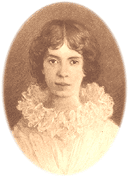|
| Portrait of Emily |

|
Emily's Life Up-Close and Personal
Emily was born on December 10th, 1830 in Amherst. Emily went to school at Amherst Academy, which used to be an all boy's
school two years earlier. She studied English, Classical Literature, Latin, Religion, History, Geology, and other subjects
throughout the years. Emily's father was Edward Dickinson, a prominent political figure, who served on the Massachusetts
Senate and the US House of Representatives. Emily's mother was Emily Norcross Dickinson who was very ill throughout her entire
life. Emily had a brother William Austin Dickinson and a sister Lavinia Norcross Dickinson. Her sister published and edited
many of Emily's poems.
The Dickinson's were strong advocated of education. She lived in her grandfather's house until she was ten. In 1840, they
moved to North Pleasant Street. Emily's windo overlooked the West Street Cemetery, which inspired much of her work. She
was a very good student but a homebody by the age of seventeen. She left for South Hadley, Massachusetts to study at a Female
Seminary but returned home less than a year later. People speculate she left because of poor health and homesickness. She
refused to sign an oath profession her faith in Christ. At the Seminary she began to write poems, and was also appreciated
as a gardener. She studied botany since age nine and er family garden was locally famous.
In 1855, Emily and Lavinia went to Washington DC and Philadelphia. In 1862, Emily published some of her poems in the Atlantic
Monthly. It was suspected that Emily had feelings for the editor Thomas Higginson. Dark times would begin to face Emily.
She saw and eye doctor in Boston and he forbid her from reading and writing. In the 1870's Emily's mother was confined to
bed and Emily had to care for her. Her father died suddenly in 1874. In 1874, she stopped going out in public and she seemed
to enjoy her solitude. In 1871, her brother's son Gilbert died of a kidney disease which further secluded her from the outside
world. Emily never married or had kids; in fact her sexuality is very disputed by biographers and critics still today.
Emily Dickinson died on May 15, 1886, at the age of 56, of Bright's disease. She once wrote, Unable are the loved to die,
for love is immortality. She rests in the West Cemetery of Amherst. She didn't want a church service and was buried in one
of her white dresses that she wore for many years. Her younger sister pinned violets to her collar. Only a few of her poems
appeared in public in her lifetime. Lavinia found hundreds of poems in Fascicles stitched together by Emily's own hand; about
40 hand-bound volumed with more than 1,700 poems. Emily's niece Martha published many of her poems in 1914.
|

